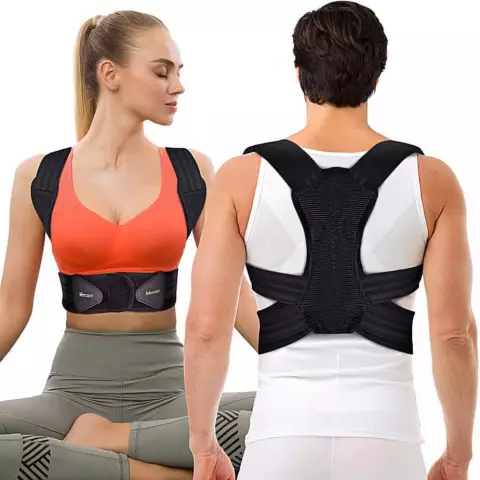- Author Rachel Wainwright [email protected].
- Public 2023-12-15 07:39.
- Last modified 2025-11-02 20:14.
Posture correction

Posture is the usual posture of a person standing at ease. With correct posture, all parts of the body are located symmetrically relative to the spine. With correct posture, a person's shoulders are deployed, the head is slightly raised, the arms and legs are extended at the joints, and the stomach is tucked up. Your doctor can evaluate the correct posture. Usually the doctor evaluates the side, back and front views. Poor posture negatively affects the functioning of all internal organs of the body. Posture correction is a set of methods designed to form correct posture or correct its existing defects.
Posture correction methods
Poor posture is sometimes confused with scoliosis. In scoliosis, the spine is curved as a result of the rotation of the vertebrae around its axis. Scoliosis cannot be corrected; you can only stop its progression. Posture disorders can be easily corrected using special posture correction methods. The use of a corset for posture correction is one of the easiest ways.
Corset for posture correction helps to restore the physiologically correct position of the shoulder girdle, as well as relieve excessive stress on the vertebrae of the lumbar and thoracic spine while maintaining normal muscle tone. The posture correction corset fixes the person's back in the correct position. Special elastic corset plates contribute to an even distribution of the load on both sides of the spine and to the symmetrical development of the muscular system.
To enhance the effect in case of incorrect posture, the doctor, in addition to the corset, may advise physical therapy classes aimed at strengthening the muscles. In the future, the exercises are corrected by the instructor, based on the physical fitness and the state of the patient's musculoskeletal system.
The best results can also be achieved with the combined use of various methods of posture correction - a corset, physiotherapy exercises and therapeutic massage sessions. Swimming, volleyball and skiing are useful for correcting posture.
Posture Correction Exercises
Posture correction exercises to some extent help you better control your body and correct body flaws.
The following exercises are suitable for correcting posture and strengthening the muscles of the back:
- stand up, place your hands behind your head. With force, move your arms to the sides, raise your arms up and bend. Measure for 2-6 seconds and return to starting position;
- stand up, place a gymnastic stick behind your back. Press its lower end to the pelvis, and the upper end to the head. Lean forward and return to starting position, lean to the left, then to the right. Perform each movement 10-12 times;
- lie on your stomach. Bend over, leaning on your hands. Measure in this position for 4-5 seconds, then return to the starting position;
- stand one step away from the wall. Touch the wall with your hands and bend back, raising your arms up, return to the starting position. Repeat 6-8 times.

Hanging on a gymnastic wall can be added to the exercises for five to six minutes.
Posture correction exercises (lying on your stomach):
- stretch your arms forward, stretch your body in line, pull your hands and socks in different directions for one minute;
- hands at close range, lean on the palms and raise a straight leg in turn (10 times);
- fold your arms over your head into the lock, raise your shoulder girdle and hold out in this position for two to ten seconds (6 times);
- raise your arms and head up, do "scissors" with straight arms for one minute;
- fold your arms into the lock and stretch forward, put your straight legs together. Raise your legs, arms and head and hold for one to two minutes;
- grasp the ankles with your hands and rise up on your stomach, hold in this position for two to ten seconds (10 times).
The following exercises for posture correction should be performed on your knees:
- kneel down, lower your arms along your torso, and then lean back. Repeat 10-15 times;
- sit on the floor to the right and left of the feet;
- reach your forehead with your knee, throw your leg and head back up. Repeat 10 times.
All exercises must be performed at an average pace, while trying to turn the shoulders back as much as possible.
Posture correction in children
Methods of posture correction in children are based on the study of posture by the main elements, elimination of stiffness and unnecessary muscle tension, on the development of memorizing the correct posture and the ability to restore it in various conditions.
Posture correction in children occurs through a combination of manual therapy with exercise therapy, massage and psycho-training. For posture correction, you can also include walking on a log to train the cerebellum, vestibular apparatus, as well as develop the sensitivity of the muscles of the limbs, neck and trunk. Children of primary school age must be prescribed exercises based on deep breathing, since at this age the chest grows more slowly than the whole body.
The posture correction process must be accompanied by a consciously volitional decision of the child to all types of activities. Only in this case, mastering the skill of correct posture will occur naturally.
Found a mistake in the text? Select it and press Ctrl + Enter.






